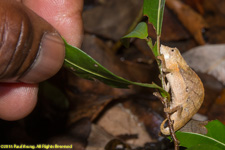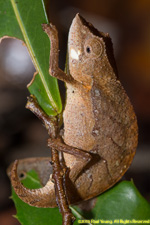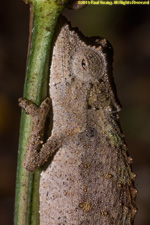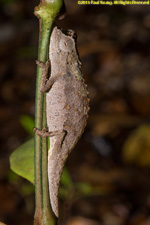



Madagascar has more than three hundred species of reptiles, 90% of which are endemic, as well as a huge variety of frogs. We are not experts on these animals; if you find we have misidentified or could not identify an animal, contact us and we will correct it.
Chameleons: Madagascar has both the largest and the smallest species of chameleons. There are 82 species, all endemic. Chameleons are good swimmers and can change color. Only males have "noses" (rostral protuberances). Chameleons have two or three forward-facing and two or three rearward-facing toes on each foot. They have very long tongues, crests or horns on their heads, and most species have a prehensile tail. Their eyes are independently mobile and can focus independently, providing stereoscopic vision of their prey if the reptile focuses both eyes forward. Half of all two hundred or so chameleon species are endemic to Madagascar.
Stump-tailed or leaf chameleons (genus Brookesia) include thirty described species. All are terrestrial, foraging in leaf litter for tiny insects like ants. Some climb into the lower twigs of undergrowth to sleep. Their ability to change colors is limited, and their tails are short and not prehensile.
Dwarf chameleon, Brookesia stumpfii
The minute leaf chameleon, Brookesia minima, is one of the world's smallest reptiles. They hide in the leaf litter and are found in northern Madagascar.
The Amber Mountain leaf chameleon (Mount d'Ambre leaf chameleon), Brookesia tuberculata, is a diminutive chameleon of far-northern Madagascar.
Brookesia sp. on Nosy Mangabe.
Elephant chameleon, Calumma boettgeri
The Panther chameleon, Furcifer pardalis, green and red, may have a white stripe along its body axis. It is found in eastern and northern parts of Madagascar in tropical forests. Females are about half the size of the brightly-colored males. Males from Nosy Be are turquoise green.
The Madagascar giant chameleon (Malagasy giant chameleon, Oustelet's chameleon), Furcifer oustaleti, is endemic to Madagascar and found in a wide range of habitats. They eat invertebrates, mainly large insects. Females are green.
The carpet chameleon (jewel chameleon, white-lined chameleon), Furcifer lateralis males are green; females can be a variety of colors. They are endemic to Madagascar, found mainly in central eastern Madagascar.
Angel's chameleon, Furcifer angeli, is endemic to deciduous dry forests in central western Madagascar.
The short-horned chameleon, Calumma brevicorne, is endemic to eastern Madagascar. It has a compressed body, grasping feet, and a prehensile tail. It has large ear-like occipital lobes. The male has a short bony appendage that projects from the snout. They are generally greyish.
Nose-horned chameleon, Calumma malthe:
Calumma malthe female (?):
Calumma sp.:
The short-nosed chameleon (Perinet chameleon, Malagasy side-striped chameleon), Calumma gastrotaenia, is endemic to the humid forests of eastern and contral Madagascar.
The Parson's chameleon, Calumma parsonii, is endemic to isolated pockets of humid primary forest in eastern and northern Madagascar. It is the heaviest chameleon, although the giant chameleon can grow longer.
Oshaugnessii ambreenses. Orange animal is a juvenile female. The adult male has green around the eye.
The blue-nosed chameleon (Boettger's chameleon), Calumma boettgeri, is endemic to northern Madagascar rainforests. The blue tint is common in Amber Mountain males.
The blue-legged chameleon (cryptic chameleon), Calumma crypticum, is found in mid-elevation and montane humid forests.
Unidentified chameleons (if you can help identify one, please contact us. We can supply information about the location, date, and time, if that helps in identification.)
Geckos:
Geckos are small lizards found in warm climates. They make chirping sounds. Geckos lack eyelids. There are over 1500 species of geckos. Madagascar geckos include 103 species in 11 genera, more than any other lizard group. Most are nocturnal.
Day geckos (genus Phelsuma) include 35 species, mostly bright colored.
Madagascar day gecko, Phelsuma madagascariensis madagascariensis, is found in eastern Madagascar rainforests. It eats insects, fruits, and nectar. The animal is green or blue-green with a rust-colored stripe from the nostril to behind the eye, up to 22 cm long (8.7"), and has brown or red spots on its back.
The broad-tailed day gecko, Phelsuma laticauda, is found in northern Madagascar and Comoros, and has been introduced to Hawaii and other Pacific islands.
The modest day gecko, Phelsuma modesta
The peacock day gecko, Phelsuma quadriocellata, is endemic to Madagascar where it is abundant in low to mid-elevation habitats.
Grandidier's velvet gecko, Blaesodactylus cf. sakalava
Hemidactylus mercatorius
Blaesodactylus cf. antongilensis
The Peters's spotted gecko (fish-scale gecko), Geckolepis maculata, has large legs and large scales, and is relatively common.
Big-headed geckos (Paroedura genus) include fifteen species. They live in rainforests, deciduous forests, spiny bush, and especially around tsingy formations.
Ocelot gecko, Paroedura pictus, also called the Madagascar ground gecko, is a noctural ground-dwelling gecko found in leaf litter. The animal is brown with black markings and is 10-15 cm (4-6") long. It is fairly shy.
Paroedura lohatsara is native to a single mountain range in northern Madagascar and is mainly nocturnal. Juveniles have wide transverse bands of black and transition into the adult colors as they grow. The species is critically endangered.
Paroedura cf. karstophila
Paroedura sp.
The Madaagascar velvet gecko, Blaesodactylus boivini, is found in northern Madagascar.
Leaf-tailed geckos are endemic to Madagascar and its coastal islands. They are nocturnal insectivores. There are at least 14 species. They rest head-down during the day and have a limited ability to change color to match the tree bark.
The mossy leaf-tailed gecko (southern flat-tail gecko), Uroplatus sikorea, varies in color.
Henkel's leaf-tailed gecko (Henkel's flat-tailed gecko, frilled leaf-tail gecko), Uroplatus henkeli, has two morphs, one found on Nosy Be and the other on mainland Madagascar. They eat mostly insects.
The giant leaf-tailed gecko, Uroplatus giganteus, is one of the largest geckos.
The Satanic leaf-tailed gecko (phantastic leaf-tailed gecko), Uroplatus phantasticus, eats crickets and moths.
Uroplatus sp. from Nosy Mangabe (may be multiple species).
Uroplatus sp. from Masoala.
Uroplatus cf henkeli from Andrafiamena.
Other reptiles:
The Nile crocodile, Crocodylus niloctus, is the largest terrestrial animal in Madagascar.
Snakes:
Madagascar has more than eighty snake species, none dangerous to humans. There are four families of snakes: boas, lamprophids, and two burrowing snakes. Most Madagascar snakes are lamprophid snakes (81 species).
The blonde hognose snake, Leioheterodon modestus, is native to Madagascar. The hognose is a modified scale allowing the snake to use its snout as a shovel to dig up buried iguanid eggs, its favorite food.
There are six subspecies of cat-eyed snake (Malagasy cat-eyed snake), Madagascarophis colubrinus, a small mildly-poisonous colubrid snake native to Madagascar. They are mainly nocturnal.
Surprisingly, there are three speies of boas in Madagascar. Their closest relatives are in the South Pacific and the Amazon Basin, although mainland African has sand boas.
The Madagascar tree boa (Malagasy tree boa, manditra), Sanzinia madagascariensis, is semi-arboreal and is easy to recognize by its high supralabial scales which are separated by deep furrows.It is a non-venomous species endemic to Madagascar. Females are larger than males. There are two subspecies. They are smaller than ground boas and more common. They vary widely in color.
Sanzinia madagascariensis madagascariensis is found in the east and south. It is usually greenish.
Sanzinia madagascariensis volontany is found in the north and west and is usually brownish.
The Madagascar ground boa (Malagasy ground boa, Madagascar boa), Acrantophis madagascariensis, is endemic to Madagascar. Females are larger than males. It is Madagascar's largest snake. It resembles the Central and South American boa constrictor. They hunt mainly at night and eat small animals, including lemurs.
Compsophis vinckei is a harmless lamprophiid snake native to Madagascar.
The Madagascar burrowing snake, Pararhadinaea quadrilienatusis found in northern Madagascar and on Nosy Be in dry deciduous lowland forests.
Mimophis mahfalensis is a Colubrid snake found in Madagascar. They eat frogs and small lizards, including chameleons.
Mimophis occultus is a related northern Colubrid snake species. Until 2017 it was considered the same species as Mimophis mahfalensis.
Pseudoxyrhopus tritaeniatus is usually black with four red stripes, though at Nosy Mangabe where this animal was photographed there may be a fifth stripe. Usually this snake hides during the day, often under rotten wood, and is active at night. It is endemic to Madagascar.
The plateau brook snake, Pseudoxyrhopus imerinae, is a poorly-known montane species.
The whip snake (Bernier's striped snake), Dromicodryas bernieri, inhabits humid forests and arid spiny savanna and thornbrush scrub.
The Malagasy giant hognose snake (menarana), Leioheterodon madagascariensis, eats frogs, rodents, and birds. When photographing these two at Andrafiamena, we thought they were mating but it appears this is a combat between two males.
Tortoises and turtles: Madagascar has five species of tortoises, four of them endemic, and four species of freshwater turtles.
The radiated tortoise, Astrochelys radiata, is native to southern Madagascar. They are found in very dry areas of the spiny forest.
Ploughshare tortoise (angonokea, angonoka, Madagascar tortoise, Madagascat angulated tortoise), Astrochelys yniphora. Adults have a large spur on the frontal part of the plastron. This is one of the rarest tortoises in the world. They are native to dry deciduous forests. They are Madagascar's largest terrestrial tortoise. The long upturned spur which projects forward from the plastron (lower shell) gives them their name.
Spider tortoise, Pyxis arachnoides. They are found in coastal areas of southern and southwestern Madagascar in dunes and thornbrush. They are endemic to Madagascar and are endangered.
The flat-backed spider tortoise (flat-tailed tortoise), Pyxis planicauda, is endemic to the western coast of Madagascar between Morondava and the Tsiribihina River. They are found in dry deciduous forest, spending the dry season burrowed aestivating in the leaf litter and are active during the wet season. This species is critically endangered.
The African helmeted turtle (marsh terrapin, crocodile turtle, African side-necked turtle, omniverous side-necked terrapin), Pelomedusa subrufa. They are found in western Madagascar in stagnant water bodies and even puddles. They are also found in much of sub-Saharan African and in southern Yemen.
Madagascar big-headed turtle, Erymnochelys mdagascariensis. They live in open water areas of large, slow-moving rivers, backwaters, and lakes. They spend the dry season buried in the mud. Their nearest relatives are in South America.
Lizards:
Plated lizards are native to Madagascar and Africa. In Madagascar they are found in the eastern and western regions. There are 17 species of zonosaurs.
Plated lizard (Jeweled zonosaur), Zonosaurus ornatus.
The Madagascar zonosaur (Madagascar girdled lizard, Madagascar plated lizard), Zonosaurus madagascariensis, is found on Madagascar, some outlying islands, and on Cosmoledo in the Seychelles.
Skinks:
Skinks have no pronounced neck and their legs are relatively small (some species have no limbs at all). Worldwide there are 1570 species, 76 of which are found in Madagascar.
The smart mabuya (elegant mabuya), Trachylepis elegans
The gold-spotted mabuya, Trachylepis aureopunctata, is native to Madagascar.
The Madagascar jungle skink, Trachylepis gravenhorstii:
The gold-spotted mabuya, Trachylepis aureopunctata is found in arid environments in western and southern Madagascar.
Trachylepis volamenaloha is found in west-central Madagascar, in dry deciduous forests associated with limestone tsingy formations.
Iguanas:
There are no iguanas in Africa or Asia, although there are some Asian fossils. So it is surprising that Madagascar has seven species of iguanas. Most iguanas are found in Central and South America. Madagascar iguanas are mostly found in the west and south west and the drier parts of the central highlands.
Chalarodon madagascariensis is a terrestrial iguanian lizard of semi-arid and arid regions of southern, western, and southeastern Madagascar.
The spiny-tailed iguana (collared iguanid), Oplurus cuvieri, is found in tropical forests in western Madagascar and on Grande Comore.
The collared iguanid lizrd (collared iguana, Madagascar collared iguana, Cuvier's Madagascar swift), Oplurus cuvieri cuvieri, is the largest of the six Oplurus species.
The Madagascar blue iguana, Oplurus fierinensis, is endemic to southwest Madagascar, the area around Toliara.
Frogs are the only amphibians in Madagascar (there are no newts or salamanders). There are at least 300 species, all but three of which (probably introduced by man) are endemic. Most are nocturnal.
We have been unable to identify the majority of the many species of frogs we encountered. If you can identify any of them, please contact us. We can supply the date and location of the photographs taken.
Unidentified frog, Boophis sp.
Heterixakus carbonei
Unidentified frog
Unidentified frog
Boulanger's Madagascar frog, Gephyromantis boulengeri, is endemic to Madagascar, found in rainforests of eastern and northeastern Madagascar and Ile Sainte-Marie.
Boophis pyrrhus is a Mantillidae frog endemic to Madagascar's subtropical and tropical moist lowland forests.
Boophis doulioti is found mostly in western Madagascar.
Unidentified frog
The sculpted Madagascar frog, Gephyromantis sculpturatus, is a Mantellidae frog endemic to Madagascar's subtropical and tropical moist lowland and moist montane forests.
Stumpffia tetradactyla is a Microhylidae frog endemic to Madagascar's subtropical and moist lowland forests.
Baron's painted mantella (variegated golden frog, Madagascan poison frog), Mantella baroni, is a Mantellidae frog endemic to Madagascar's subtropical or tropical moist forests and montaine forests. The skin is toxic.
Unidentified frog
Unidentified frog
Unidentified frog
Unidentified frog
Unidentified frog
Unidentified frog
Unidentified frog
Unidentified frog
Unidentified frog
Unidentified frog
Unidentified frog
Unidentified frog
Unidentified frog
Grenn-backed mantella, Mantella laevigata
Unidentified frog
Unidentified frog
Madagascar reed frog, Heterixalus cf. madagascariensis
Unidentified frog
Pandanus frog, Guibemantis cf. liber
Plethodontohyla guentheri
©2016, 2017, 2018, 2019, 2020 Mermaid Underwater Photographic. All Rights Reserved.
Contact us at mermaid@underwater.org.
Last modified 30 March 2020